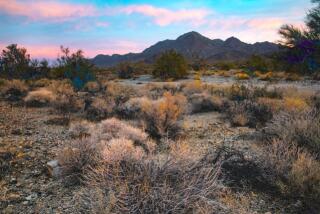City to Discuss Site With Native Americans : Thousand Oaks: Officials agree to answer accusations that they hid the significance of bones found in what some say is a burial ground.
- Share via
Thousand Oaks city and park officials agreed Monday to meet with Chumash leaders to answer accusations that they hid the importance of human bones unearthed on Lang Ranch to make sure a park was built there.
City planner Greg Smith insisted, meanwhile, that a review of facts will clear the city of any wrongdoing. And park officials said the dispute was the result of miscommunication between two branches of the local Native American community.
The officials said a meeting would help clarify the significance of the bones found on an eight-acre ranch parcel four years ago, and determine if anything should be done to protect what Chumash think is an ancient cemetery.
“We want to work in concert with everyone involved,” said Tex Ward, general manager of the Conejo Recreation and Park District. “Our motives are pure, and I hope everyone comes to the table with that understanding.”
Ward said the district planned to build a park on the land because he and a Chumash representative agreed that was the best way to prevent developers from building homes there.
Richard Angulo, a Native American present when the bones were reburied, confirmed that he advised Ward to build the park.
“They said they would only put trees on top of the burial ground, and that the baseball diamond and soccer field would go on another part of the land,” Angulo said. “We all felt that decision would save the land from having homes built on it.”
Other Native Americans have opposed the construction of a park, fearing playing fields and picnic areas would be located atop the site where bones were unearthed in 1990.
They said Monday they would urge park officials to leave the land entirely undeveloped.
“I believe what’s there is a cemetery, and I don’t think anything should go there,” said Paul Varela, director of the Native American Interpretive Center in Thousand Oaks. “We need to sit down with them and get this worked out, so everyone is in agreement.”
*
Last Friday, angry Native Americans accused city and park officials of misrepresenting the importance of the discovered bones to ensure that a neighborhood park was built.
At a meeting the previous evening, city officials told some Chumash that the city had re-evaluated the importance of the bone fragments and beads and determined they were not part of a Chumash cemetery.
That conclusion was disputed by a city-approved archeologist who made the actual discovery. He said no more bones were found only because the park district asked him to halt his inquiry.
But Ward said Monday that the archeologist, William Clewlow, and local Chumash agreed in 1990 that further excavation would only damage the burial sites.
Disagreement within the local Native American community has made matters more complicated than necessary, Ward said.
“It’s tough when you’ve got two or three factions that disagree,” he said. “But we have to look at this from the grand view of things.”
“Whether it’s a burial ground or not,” he said, “I think it’s clear, given the alternative, that a park is the most appropriate design for this land.”
Smith declined to comment fully until he gathered all the facts, but said “the city has done nothing wrong, and the record will bear that out.”
*
Some local Native Americans said last week that the city violated state law by failing to contact the Ventura County coroner and the California Native American Heritage Commission when the human remains were originally found.
But Angulo said he had called the Heritage Commission about the find. Larry Myers, the commission’s executive secretary, said he found no record of the contact.
“There are a lot of issues that need to be hashed out and resolved,” said Councilman Frank Schillo, who requested the meeting. “I hope we can work this out to everyone’s satisfaction.”
More to Read
Sign up for Essential California
The most important California stories and recommendations in your inbox every morning.
You may occasionally receive promotional content from the Los Angeles Times.













